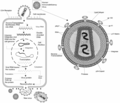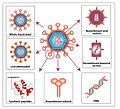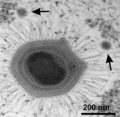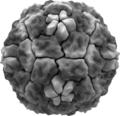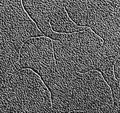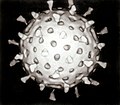A virion (plural, viria or virions) is an inert virus particle capable of invading a cell. Upon entering the cell, the virion disassembles and the genetic...
9 KB (1,000 words) - 02:23, 23 February 2025
HIV (redirect from HIV virions)
a mature HIV virion. Only mature virions are then able to infect another cell. The classical process of infection of a cell by a virion can be called...
124 KB (14,184 words) - 18:01, 24 February 2025
Poxviridae (redirect from Intracellular mature virion)
Poxviridae viral particles (virions) are generally enveloped (external enveloped virion), though the intracellular mature virion form of the virus, which...
29 KB (3,272 words) - 20:25, 3 February 2025
Virion is another name for a virus particle. Virion may also refer to: Charles Virion (1865-1946), a noted French sculptor and ceramicist Pierre Virion...
322 bytes (72 words) - 21:48, 22 August 2017
Charles Louis Eugène Virion (Ajaccio, 1 December 1865 - Montigny-sur-Loing, 30 December 1946) was a noted French sculptor, medallist, and ceramicist, principally...
2 KB (215 words) - 14:03, 8 April 2024
Although virions of different retroviruses do not have the same morphology or biology, all the virion components are very similar. The main virion components...
41 KB (4,727 words) - 11:54, 17 January 2025
Measles virus (section Genome and virion structure)
sense copy using the RNA-dependent RNA polymerase that's included in the virion. Then this copy is used to create a new negative copy, and so on, to create...
17 KB (1,908 words) - 11:13, 4 August 2024
(also called the "virion") is 80–120 nanometers in diameter, such that the smallest virions adopt an elliptical shape; larger virions have a filamentous...
60 KB (6,049 words) - 14:28, 24 February 2025
around the virion) of HIV virions Chemical or organic attachments to the virion Here, "damage" means inhibiting or stopping the ability of virion to process...
48 KB (5,611 words) - 00:01, 23 February 2025
infecting a cell, viruses exist in the form of independent viral particles, or virions, consisting of (i) genetic material, i.e., long molecules of DNA or RNA...
154 KB (18,247 words) - 12:10, 1 February 2025
the envelope. This whole particle is known as a virion. The structural components of a typical HSV virion are the Lipid bilayer envelope, Tegument, DNA...
32 KB (3,013 words) - 02:37, 5 February 2025
Bacteriophage (section Virion assembly)
second largest component of biomass after prokaryotes, where up to 9x108 virions per millilitre have been found in microbial mats at the surface, and up...
82 KB (8,719 words) - 14:53, 18 February 2025
Baculoviridae (section Structure of the virion)
particles are resistant to heat and light inactivation, whereas the naked BV virion is more sensitive to environment.[citation needed] When infecting a caterpillar...
25 KB (2,862 words) - 18:52, 18 February 2025
structures, called spikes or peplomers, that project from the surface of the virion. The distinctive appearance of these spikes when visualized using negative...
75 KB (7,414 words) - 00:23, 5 December 2024
realm of viruses that includes archaeal viruses that have a filamentous virion (i.e. body) and a linear, double-stranded DNA genome. The genome exists...
15 KB (1,666 words) - 04:38, 29 January 2025
messenger/viral RNA, they are not all expressed at the same levels. An MS2 virion (viral particle) is about 27 nm in diameter, as determined by electron microscopy...
15 KB (1,716 words) - 16:56, 30 September 2024
distinct retrovirus in patients with AIDS which was later named HIV." Each virion comprises a viral envelope and associated matrix enclosing a capsid, which...
33 KB (3,929 words) - 19:07, 2 September 2024
major component of the virion encasing the nucleic acid of the respective MGE and therefore the gene encoding the major virion protein itself or MGEs...
34 KB (3,380 words) - 17:48, 3 February 2025
infection many mimivirus virions are clearly visible within the cell. The cell cytoplasm continues to fill with newly synthesised virions, and about 24 hours...
21 KB (1,971 words) - 01:11, 14 February 2025
infectious by itself as it needs to be transcribed into positive-sense RNA; each virion can be transcribed to several positive-sense RNAs. Ambisense RNA viruses...
36 KB (3,819 words) - 20:34, 2 January 2025
Rev (HIV) (redirect from Regulator of Virion)
proteins, and its name has been changed to Rev (regulator of expression of virion proteins), which more generally describes its function. Rev is a 13-kDa...
25 KB (3,100 words) - 04:44, 3 December 2023
non-enveloped particles (mature virions), and enveloped particles (extracellular virions). The structure of the virions is consistent with that of others...
21 KB (2,676 words) - 22:08, 1 December 2024
negative-sense, single-stranded RNA genome. They have an enveloped, spherical virion. Though generally found in arthropods or rodents, certain viruses in this...
19 KB (1,980 words) - 13:17, 17 February 2025
of the virion: the DNA-filled head, the tail, and the side tail fibers. The virions self-assemble from these components, with the first virion appearing...
9 KB (1,315 words) - 23:59, 27 November 2024
Human rhinovirus genome, virion structure, and species...
29 KB (3,278 words) - 19:54, 19 January 2025
Lagovirus (section Virion properties)
species: European brown hare syndrome virus Rabbit hemorrhagic disease virus Virions consist of a capsid. The capsid is not enveloped, round with T=3 icosahedral...
7 KB (715 words) - 21:23, 28 August 2024
distinctive shape reflects their method of replication: the coat of the virion comprises five types of viral protein, which are located in the inner membrane...
32 KB (3,596 words) - 14:34, 13 January 2025
form into hairpin loops that are important during replication. Parvovirus virions are small compared to most viruses, at 23–28 nanometers in diameter, and...
32 KB (4,031 words) - 21:43, 11 January 2025
subfamily, and 78 species. Virions are enveloped and can be spherical or pleomorphic and capable of producing filamentous virions. The diameter is around...
17 KB (2,028 words) - 01:31, 13 February 2025
particles. VP2 forms the core layer of the virion and binds the RNA genome. VP3 is part of the inner core of the virion and is an enzyme called guanylyl transferase...
87 KB (9,982 words) - 04:17, 12 December 2024





